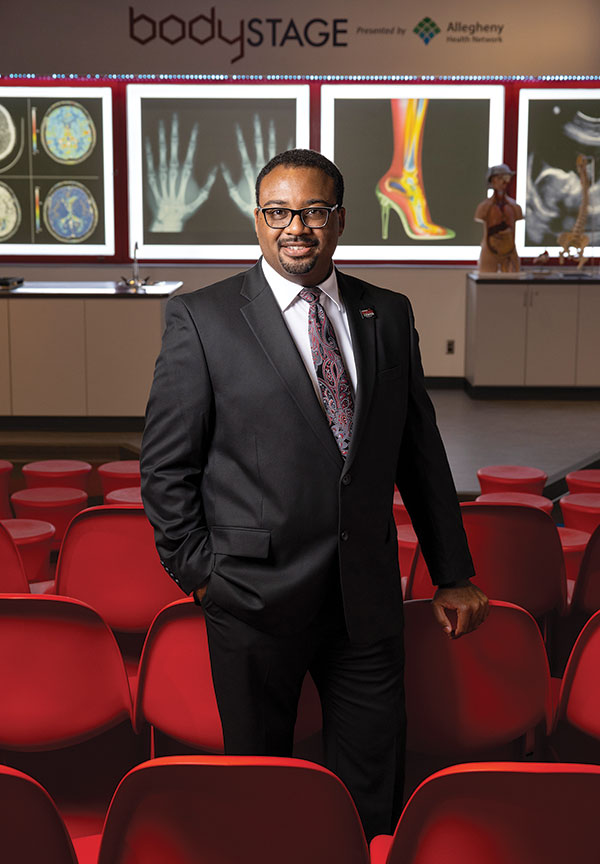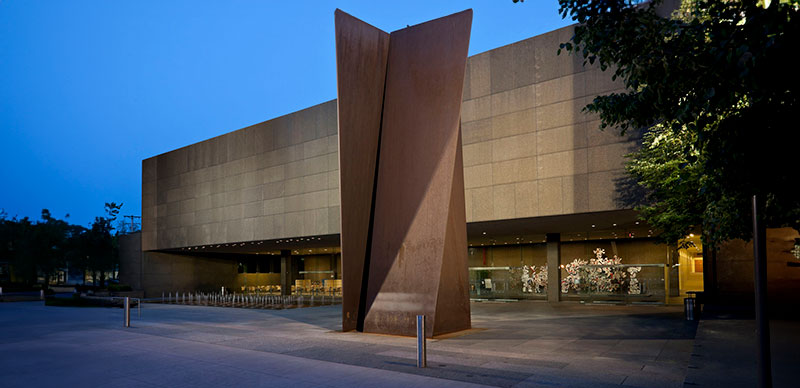
Photo: Joshua Franzos
Marcus Harshaw is senior director of museum experiences, a new position at Carnegie Science Center. When people ask him what that entails, he says, “I oversee all the fun stuff”—a long list that includes permanent and traveling exhibitions, The Rangos Giant Cinema, Highmark SportsWorks®, the USS Requin (SS 481) submarine, the Miniature Railroad & Village®, and Buhl Planetarium. Harshaw’s path to the fun stuff wasn’t a straight one. He managed a pizza chain before attending college for education. Then he started a career based on his childhood love: museums. He’s held senior learning and community engagement posts at the Cincinnati Museum Center, the Indiana Historical Society, and the Kaleideum science center in North Carolina.
Q: How did you go from the world of restaurants to the world of museums?
A: I worked for a regional pizza chain in Indianapolis. I was in my mid-20s and I thought to myself, “I don’t like coming home at 2 in the morning smelling like pizza. This can’t be the rest of my life.” I remembered my first experiences at museums as a kid growing up in Indiana. We would visit my grandparents in Chicago and go to the Field Museum and the Museum of Science and Industry, and those were the coolest places ever. Going to a museum was inspiring.
Q: You went back to school to become a teacher. Why museum education instead of classroom teaching?
A: I didn’t like formal structure. One of the things I love about museum education is that it’s informal education. I don’t have to test anyone or worry about if you are right or wrong. We can have a conversation about what interests you. My undergraduate major was early American history. During college, I went to the Field Museum to see an exhibition on Pompeii. It’s this story about how the people of Pompeii did not live that much differently than us. Yeah, they didn’t have Wi-Fi and cellphones. But a lot of the artifacts in that exhibition were things that you probably have in your home today. Then this volcano erupts and freezes all this stuff in the city of Pompeii. I wanted to be an exhibition designer, but I can’t draw.
Q: Are you a science geek?
A: No, my background is not in science. What inspires me is when other people have the “aha” moment and they grasp a science concept. As a non-science person, I help create experiences that lead to that moment. I’m sort of the bottom denominator of the public coming to our experiences. I was brought into this role to reimagine what science exhibitions can deliver in emotional impact and relevance.
Q: How does this apply to the exhibition tentatively titled Our Destiny in Space scheduled for 2022?
A: What we’re seeking to do is move guests through what it would be like to go to Mars. There are seven galleries called zones, including the voyage and departure zone. One of my favorites is the observatory, where you’re looking back on Earth. It’s really about shifting perspectives and what we can learn about our own planet. This isn’t Mars 101. You might learn that the Martian soil is red because of iron oxide and that Mars has a thin atmosphere, but that’s not the point of the exhibition. It’s about how the questions we have about shaping Mars are similar to those we have about making Earth more sustainable into the future.
Q: You were hired shortly after the start of the pandemic. Are there ways that COVID-19 changed things permanently at the Science Center?
A: Our tour of the USS Requin is the best example of something that is not going back to the way it was before. As a result of the pandemic, we’ve learned that doing a slightly more guided tour option with fewer people is actually a better experience.
Q: Museums nationwide are reckoning with issues of equity and inclusion. How has it influenced your exhibition planning?
A: We’re inviting people outside the museum to participate in the discussions. Instead of one person saying, ‘“We are going to do a space exhibition and we’re going to talk about Mars,” we involved and will continue to connect with a diverse group of people from our community who are giving us input and feedback. When informed by the people we aspire to serve, this helps us build experiences that appeal more broadly, and invite marginalized communities not to be passive but active members of the development process.
Q: What future exhibitions are you excited about?
A: I’m very excited about the new permanent exhibition Our Destiny in Space, which is still a working title. It’s the first project that showcases how we want to develop exhibitions moving forward to involve more internal and external stakeholders, and shift to an exhibition that gets guests emotionally hooked to the story. We’re also hoping to bring in a traveling exhibition on Pompeii. Pompeii has a special place in my heart because it’s similar to the exhibition that impacted me at the Field Museum. It feels like my career is coming full circle.






